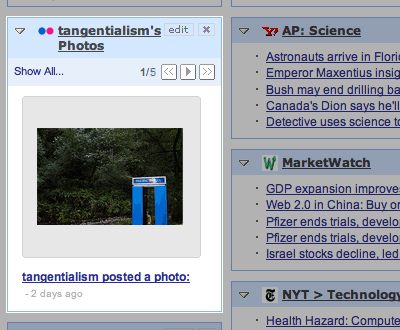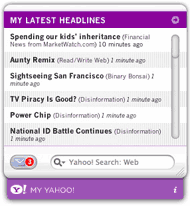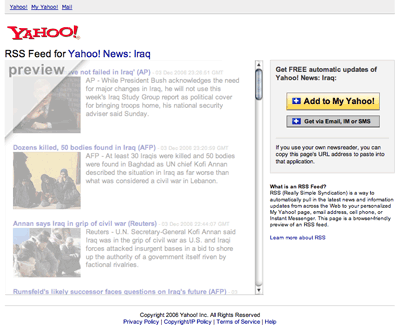My Yahoo!
I began working with the first of several My Yahoo! product teams shortly after arriving at Yahoo! (at the tail end of 2004), and right as we began rolling out a new version of the product internationally. Since that time, I’ve worked on a number of upgrades to the product, including some to be seen in the coming year.
The following examples showcase a number of solutions I’ve developed for the My Yahoo! product:
My Yahoo! Content Addition Process

Reducing the complexity of adding RSS feeds to My Yahoo! from non-Yahoo! sources required some re-engineering of the process. By simplifying the number of steps required for non-My Yahoo! users to sign up and add their selected content, this effort significantly reduced new user drop-off. I re-architected the page, as well, to better focus on the call-to-action, reduce the visual competition, and introduce alternate subscription mechanisms (such as email, SMS, and IM).
MediaRSS modules

With the release of the RSS module in the new My Yahoo! in 2004, users were able to add content from millions of publishers and sources online. While most content being published at that time worked well within a bulleted list display, media content (such as photos, audio, and video) was also presented as a series of text links. With this new module container, users were able to see media content as intended: visually and with playback controls.
Apple OS X Dashboard widget

Mac OS X 10.4 “Tiger” users are now (for the first time ever) able to view the most recent collective headlines from all their My Yahoo!-subscribed RSS feeds in Apple’s new Dashboard environment. The widget also allows checking of Yahoo! mail and initiation of Yahoo! searches. (Apple subsequently named the widget their Featured Download for May 13th, 2005.)
Download the widget to use on your Mac!
RSS feed preview

One of the most appalling user experiences around open content is that of the “raw RSS feed” encounter. The situation is as follows: a user clicks an orange “RSS” or “XML” button out of curiosity, and is rewarded with an unfamiliar page filled with raw XML code; an important lesson is learned: never, ever, click on such a button again.
To remedy this experience, I designed, user-tested, and coded an XSLT stylesheet (utilizing Yahoo!’s YUI Libraries) that can simply be referenced by the RSS feed’s code. Now, instead of seeing a code dump, users see a live preview of what they would be subscribing to and a prominent call-to-action urging them to add the feed to My Yahoo!.

